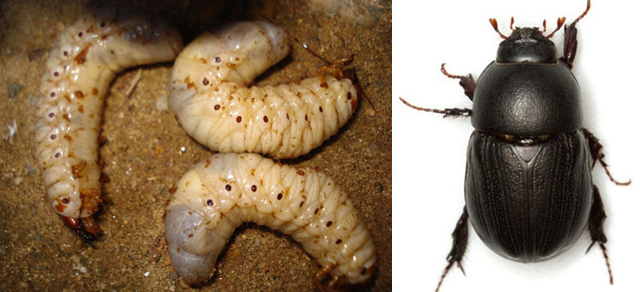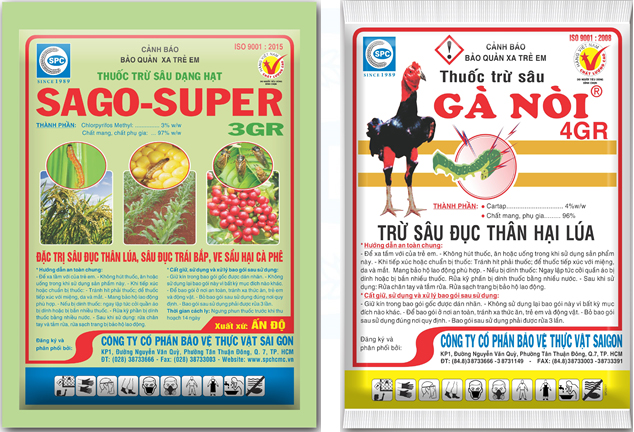|
Prevention Of Sugar Cane Damaging White Grub
23/10/2021
MSc Huynh Kim Ngoc Causing harm: Beetles (adult) and larvae cause damage by gnawing young roots and underground stems, causing poor growth, loss of plants (cuttings), poor tillering, and loss of yield. Beetles and white grubs cause damage on many crops with roots, cuttings, tubers... lying in the soil such as sugarcane, potatoes, rubber, forestry trees.... On sugarcane, beetles and white grubs damage both sugarcane grown from the root of the previous crop and sugarcane grown by cuttings , during the day creep into the ground, find holes and cracks for shelter, come up at night to bite and destroy, causing heavy damage in the months of March - May when the sugarcane is in the tillering stage, especially after the first rains of the season. Characteristics: White grubs are larvae of beetles living in the ground, the body is C-shaped, the body is large, fat, milky white, the belly is bulging, there are legs in the thorax. The beetles, white grubs are often harmful when the weather is dry. On sugarcane, adult beetles lay eggs around the base of sugarcane, the eggs hatch in 15 days and hatch into larvae (white worms) that live for 5-6 months in the ground and then pupate. Larvae and adult beetles gnaw root and base of sugarcane, lying at the base of sugarcane during the day. The beetle causes strong damage when the sugarcane is tilling (March - April), killing the tree, affecting the tillering rate, when the sugarcane is large (June), the beetle causes two milder problems. Treatment: In general, beetles and white grubs are relatively difficult to treat, so it is necessary to apply many measures such as: - Rotating other crops such as legumes, vegetables, rice... (if possible) - Plow deeply,earth up beds, clean up the remnants of the previous crop. - Weeding combined with catching white grubs... before placing cuttings. - Planting at the right time, concentrated planting. - Inundation (if the field is actively irrigated). - Hand catching (adult beetles and white grubs) if the density is too high, it is possible to combine the use of light trap, this measure needs to be done continuously for 2-3 weeks, at the same time, the lighting time of the traps is from late evening to . midnight - Use chemical products such as: Sago Super 3G (Chlorpyrifos methyl), Ga Noi 4G (Cartap) ... the product can be spread in rows, when earthing up beds or applying root fertilizers. The amount used depends on white grubs less, more, the dose varies from: 20- 40 kg/ha, before applying with product , the field should be lightly plowed, then sprinkled and lightly watered so that the product can seep down below.
|
To prevent, in addition to plowing and burying weed seeds, collecting weed stalks and stumps left after tilling the land to burn, not letting weeds produce seeds in production fields, etc., the use of chemical products is still a measure. optimal because of its ability to thoroughly kill weeds, reduce labor and take advantage of more time than manual weeding.
Miner has the scientific name Phyllocnistis citrella Staint., family Phyllocnistidae, order Lepidoptera. The miner occurs in many countries in the tropics and subtropics. The main host of the miner is the citrus family - Rutaceae. In addition, the miner also attacks mangosteen and some other plants.
Adult is a small planthopper, with a body 2-3 mm long, the whole body is ash gray, slightly greenish, the wings are opaque with many small brown spots.Eggs are oval, 0.3 mm long, have a pointed end and are attached directly to the leaf surface, leaf axils.
Green bugs specialize in the fruit of citrus groups (oranges, tangerines, lemons, grapefruits, kumquats...), some people call them orange bugs, or orange suckers. Their scientific name is Rhynchocoris poseidon or Rhynchocoris humeralis.
In Vietnam, yellow leaf curl disease is very common on papaya trees, especially the disease is often severe in areas of high and continuous planting, areas with hot and arid climates. The disease has significantly reduced the yield and quality of papaya. Gardens that are infected early when the plants are young may not yield. However, up to now, many gardeners still do not know the cause and how to fix it.
Spider mites are common pests on citrus trees, especially in hot and dry climates that are suitable for spiders to grow and cause severe damage.The group of harmful spiders is usually very small in size, unlike the natural enemy spiders.
This group includes species that are generally very small in size, causing damage by sucking plant sap (on leaves, fruits, branches, stems).
There are many species of mealybugs present on the group of Oranges,Tangerines,Grapefruits and Lemons (Citrus), which can be divided into 2 groups:
+ Group of sticky mealybugs with common varieties such as Lepidosaphes, Aonidiella, Coccus and Saissetia.
+ Group of flower mealybugs with common genera and species such as Pseudococcus, Planococcus and Icerya purchasi.
Dry branches and berries disease often appear to be common damage on coffee gardens during the rainy season. The disease causes death of branchs, dry fruit, severely affects the canopy structure and coffee yield if not paid attention to prevention.
Pink disease commonly causes diseases on rubber plantations in the rainy season, especially on garden from 4-8 years old. This year, rubber has to go through a period of severe drought, weakening the tree, so now in tnshe rainy season it is easy to get infected. Therefore, it is necessary to pay attention to good management to avoid affecting the garden.
In recent years, the area of citrus has been expanded because it is a fruit tree with high economic efficiency. However, in order to sell at a high price, not only in quality but consumers also require the external beauty of the fruit, so pest management on citrus is a matter of great concern to farmers. The hot season is a favorable condition for thrips to develop and cause damage, affecting the commercial value of fruit.
- Headquarters
- SAIGON PLANT PROTECTION JOINT STOCK COMPANY
- RQ 1, Nguyen Van Quy St., Tan Thuan Ward, HCM City
- Tax code: 0300632232
- Tel: (028) 38 733 295 - 38 732 077
- Fax: (028) 38 733 003 - 38 733 391
- Website: www.spchcmc.vn - Email: info@spchcmc.vn
- SAIGON PLANT PROTECTION COMPANY
- SAIGON PLANT PROTECTION JOINT STOCK ENTERPRISE
- Lot C1-C3 Hiep Phuoc Industrial Park, Hiep Phuoc Commune, HCM City
- Tel: (028) 3873 4089 - Fax: (028) 3873 4086
- Affiliated Unit
-
- Quick Links
- Home
- About us
- Career Opportunities













